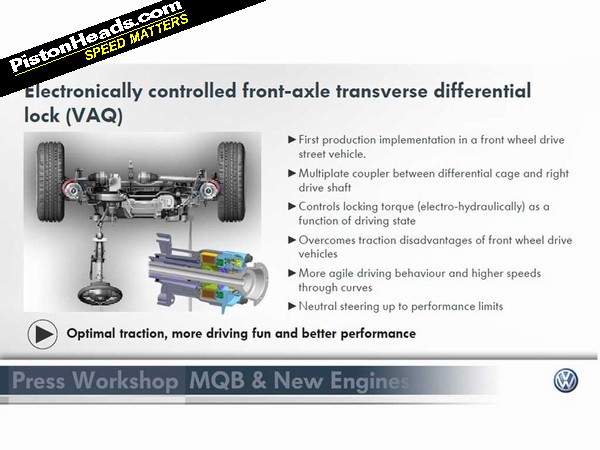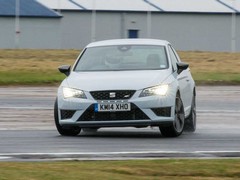VW's VAQ 'diff' explained
Is it an 'e-diff', a limited-slip diff or even a diff at all? Chapter and verse on VAQ here...


Front differential lock
A newly engineered electronic front differential lock is being used exclusively in the Golf GTI Performance. To date, Volkswagen is the only carmaker to utilise an electronically controlled differential lock in a front-wheel drive production model. Compared to purely mechanical locks, the front differential lock integrated in the Golf GTI Performance offers advantages such as a variable degree of locking and comprehensive interfaces to the ESC, EDS and XDS+ functions. This makes it possible to completely avoid negative effects on steering response and steering precision that otherwise occur with mechanical locks. As a result, the system realises the full potential and maximum performance of a differential lock with regard to vehicle dynamics, because comfort is not impaired under any circumstances.
Functionality of the front differential lock. The front differential lock operates without any power losses here, so that the power produced by the engine is transferred 100 per cent to the road and is fully available to propel the GTI.
The electronic front differential lock utilises a multi-plate unit located between the right side driveshaft and the differential case. The hydraulic pressure needed to actuate the plates is generated by an electric motor driven piston pump. The locking moment that is generated here is proportional to the hydraulic pressure. The hydraulic pressure is controlled by the pump speed that is prescribed by a control module. This control module takes numerous parameter inputs - such as wheel speed, vehicle speed, yaw rate and transverse acceleration - and computes the ideal locking moment.
1,600 Nm maximum locking moment. If the control module detects wheel slip at one of the front wheels, the plates are actuated to redistribute the drive torque from the wheel with the lower grip level to the wheel with the higher level. The maximum locking moment is 1,600 Nm, so that if necessary all of the drive torque can be directed to just one front wheel; that corresponds to a locking value of 100 per cent. This produces maximum traction for a front-wheel drive vehicle, even under difficult roadway conditions and in turning situations.
Torque vectoring effect. When accelerating out of a bend, the drive torque is increased at the wheel on the outside of the bend. This produces an asymmetrical drive torque distribution that matches the dynamic wheel load distribution. This is known as a "torque vectoring effect" which reduces acceleration-related understeer. As a result, the Golf GTI Performance handles neutrally and precisely tracks along the ideal line. The existing grip level is optimally exploited. This lets the driver apply much greater force to the accelerator pedal at the apex of a bend, which in turn results in significantly higher speed exit speeds of the Golf GTI Performance out of bends.
ESC intervenes more gently and with delay. In highly dynamic situations, such as in fast driving through alternating curves, unexpected avoidance manoeuvres or load changes, the front differential lock is used to dampen yaw movements. When oversteer occurs, the front differential lock generates a stabilising yaw moment; this means that ESC interventions can be made gentler and later or might even be avoided altogether. So, the controlled front differential lock stands for even more driving fun and better performance.
ESC Sport
In the new Golf GTI, Volkswagen is offering the "ESC Sport" function for very experienced drivers. The system is activated by a two-stage switch on the centre console. If the driver pushes the button once briefly, it deactivates the ASR function (traction control). When the button is pressed longer than three seconds, Electronic Stability Control (ESC) switches to the "ESC Sport" mode. In very fast driving with lots of bends - such as on a race course - the ESC system reacts with a delay, which enables even greater agile handling properties. As an alternative to activation by the pushbutton on the centre console, ESC can now also be activated or deactivated by settings in the CAR menu.
[Source: Volkswagen]
Gassing Station | General Gassing | Top of Page | What's New | My Stuff





